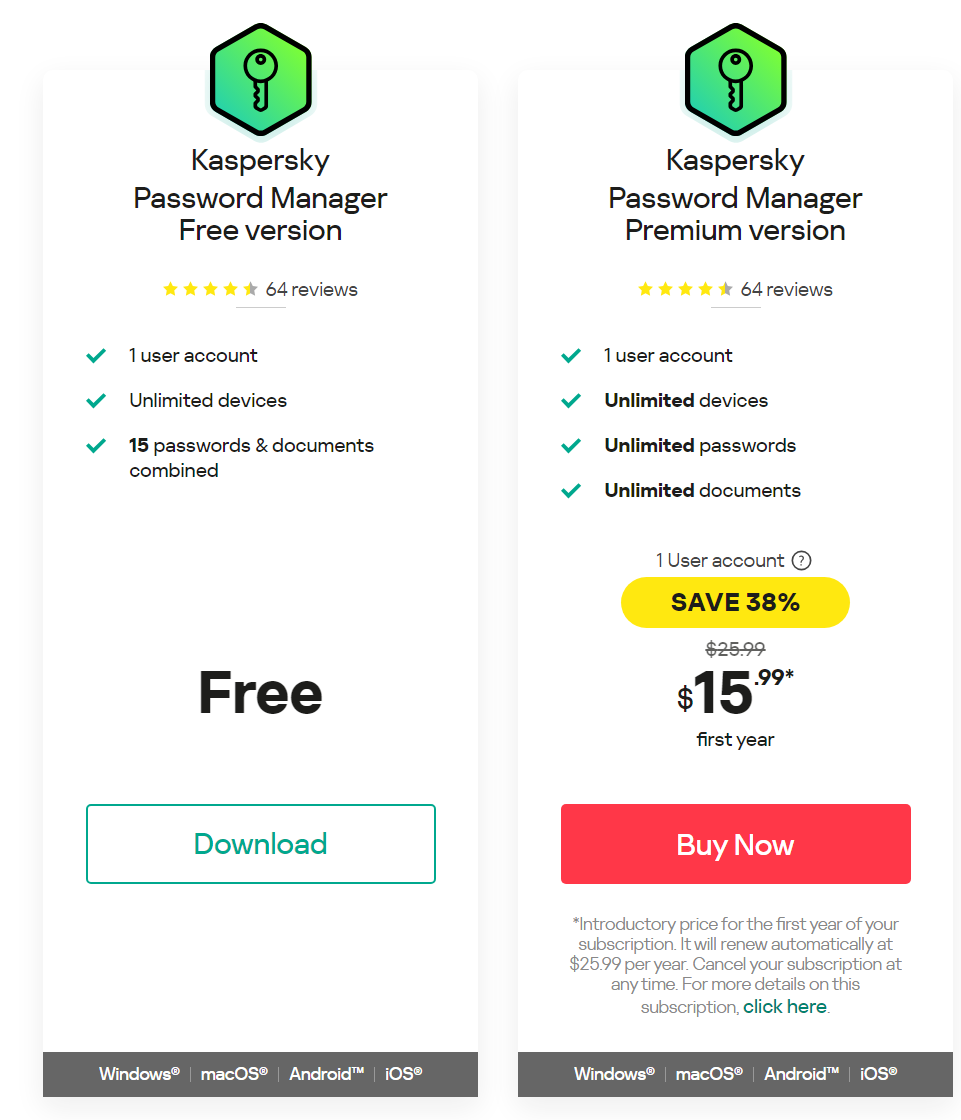Windows users: You will get leak detection at a low price point.
- Home
- / Kaspersky Review 2024: Expert Rated 3...
Kaspersky Review 2024: Expert Rated 3.7/5
We put Kaspersky password manager to the test for plan value, compatibility, features, and security. See why The Password Manager rated Kaspersky 3.7/5.

By: Gunnar KallstromHead of information systems and cybersecurity research
Kaspersky: A Quick Overview
Bottom line: Kaspersky offers an affordable password manager in its category. If you’re looking for a cheap password manager, it may be a good choice, though other free options may be better. Its performance and user experience (UX) are somewhat limited.
Who should choose Kaspersky? Windows users might find value in Kaspersky due to its leak detection software.
Overall: (3.7)
As a bare-bones password manager, not much stands out for Kaspersky features-wise. Due to the poor performance and UX, several free password managers provide much better value.
- Plans and pricing: (4.0)
- Platform: (4.0)
- UX: (3.5)
- Form filling: (3.0)
- Security: (4.0)
- 2FA: (4.0)
| Kaspersky standout features | |
|---|---|
| Low cost |
|
| Best for | Windows users who want leak monitoring at a low price |
| Promotion | None |
What Are the Pros and Cons of Kaspersky?
Kaspersky stakes its reputation on leading cybersecurity technology. Its password manager is not its primary product, resulting in clear shortcomings. It’s not a pricey password manager, but it hardly stands out from free alternatives.
Pros
- Low cost: At just over $1 per month, Kaspersky comes at a low price.
- Leak detection: While this feature is only available to Windows users, it’s attractive for the price point.
- Secure document storage: Use your Kaspersky account for more than just logins with secure document storage.
Cons
- Poor autofill: I found Kaspersky’s autofill capabilities subpar.
- Limited free version: This version only allows you to store up to 15 total items in your vault, making it one of the most limited free password managers.
- No leak detection for Mac users: Only Windows users will get leak detection, which is one of Kaspersky’s only standout features.
- Lackluster browser extension: You cannot access your vault via the browser extension.
- No business or family version: Kaspersky’s password manager is only for personal users.
Who Should Choose Kaspersky?
Kaspersky Plans and Pricing
Overall: (4.0)
Kaspersky only offers free and premium plans. The latter is $15.99 per year, one of the most affordable paid plans. Yet both versions are outperformed by many free competitors. Kaspersky loses points for its low relative value and lack of family and business plans.
| Free | Premium | |
|---|---|---|
| Price | Free | $15.99 per year |
| Best for | Users with less than 15 items | Windows users |
| Free trial | None | None |
| Platform compatibility | Android, iOS, Mac, Web (Chrome, Edge, Firefox, Microsoft Edge, Opera, Safari), Windows | Android, iOS, Linux, Mac, Web (Chrome, Edge, Firefox, Microsoft Edge, Opera, Safari), Windows |
| Autofill capability | Yes | Yes |
| Guest accounts | No | No |
| Number of passwords | 15 | Unlimited |
| Password sharing | No | No |
| 2FA | Yes | Yes |
| Account recovery | Yes | Yes |
| Support types | Live chat, email | Live chat, email |
| Encryption | AES 256-bit | AES 256-bit |
| Reporting capabilities | No | No |
| Single sign-on (SSO) | No | No |
Kaspersky Platform Compatibility
Overall: (4.0)
Kaspersky does not definitively list which platforms its password manager is compatible with. However, based on my research, Kaspersky is compatible with:
- Step 1.Android
- Step 2.iOS
- Step 3.Mac
- Step 4.Windows
- Step 5.Browsers (Chrome, Edge, Firefox, Opera, Safari, Yandex)
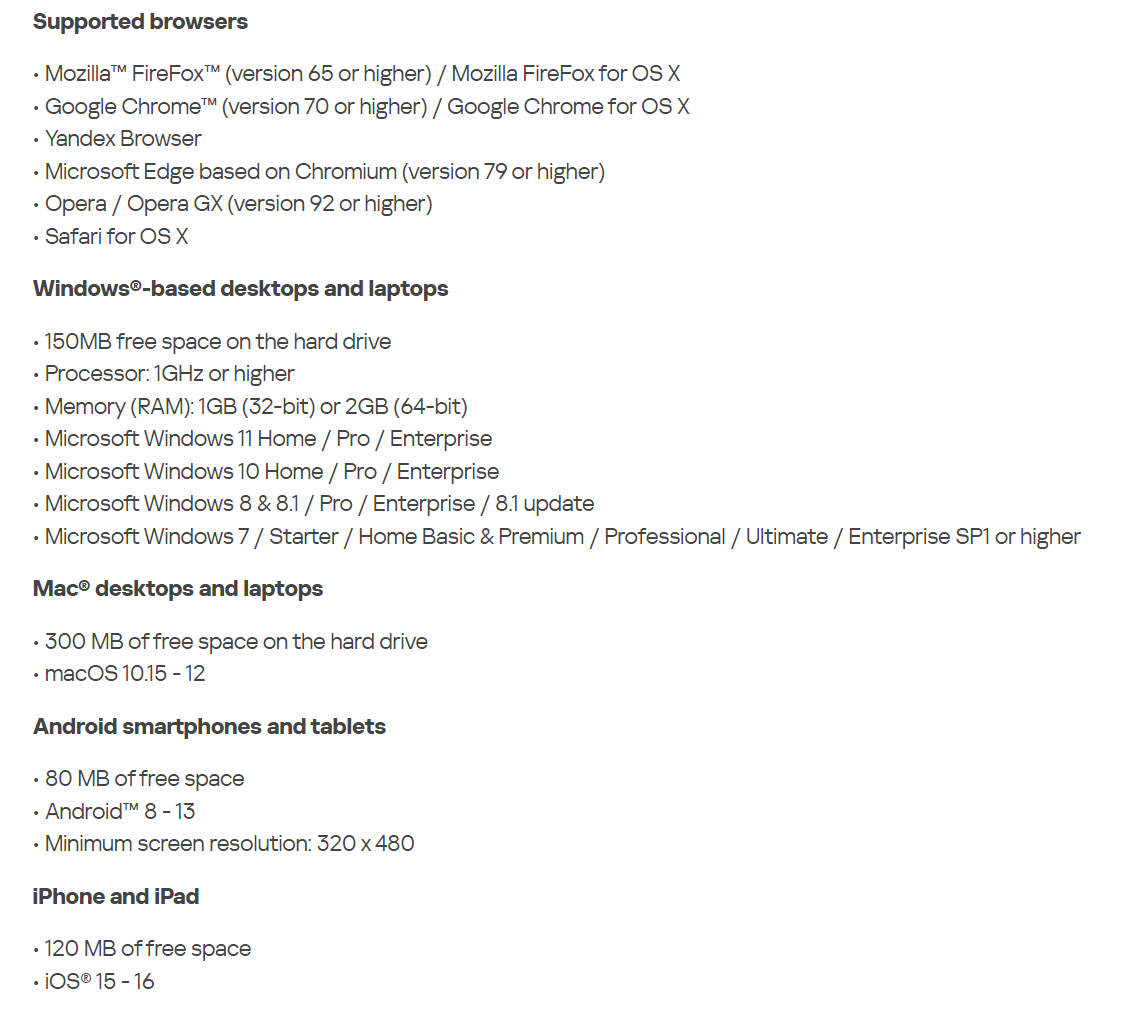
For most people, Kaspersky will be compatible with their platform of choice. That said, I’d like to see Kaspersky introduce compatibility with platforms like Linux and Brave.
Kaspersky UX
Overall: (3.5)
Kaspersky’s desktop app is one of the cleanest and most minimal I’ve tested. These are the two biggest factors I’m looking for in a password manager’s app.
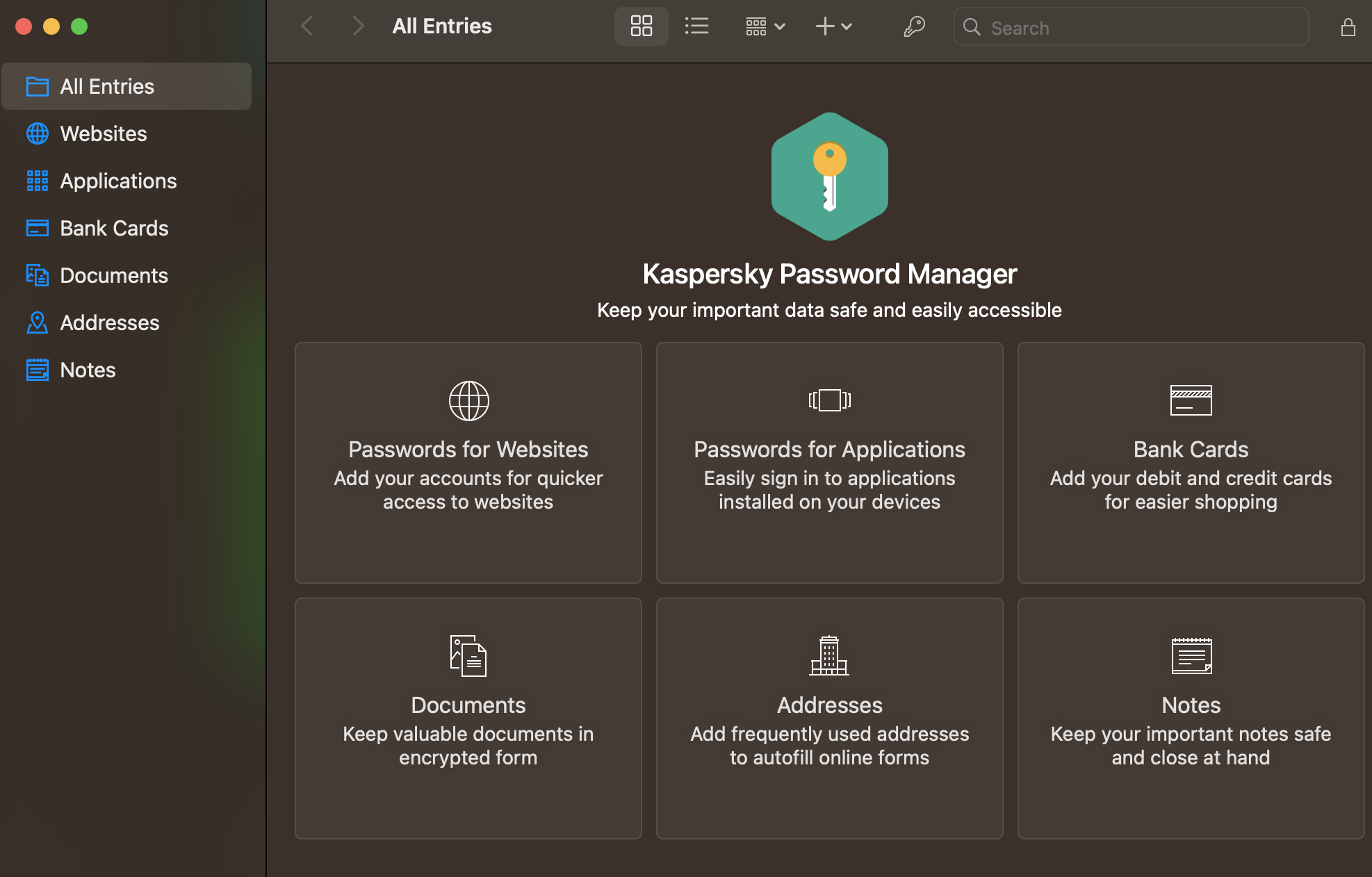
Kaspersky’s browser extension performs fine with its autofilling and auto-capturing. However, competitors like 1Password and Dashlane offer greater usability by allowing you to access and make changes to your vault via the browser extension. Kaspersky does not, taking away much of its potential functionality. Also, in cases where the browser extension autofilled information incorrectly or not at all, it would often lag or fail to open at all.
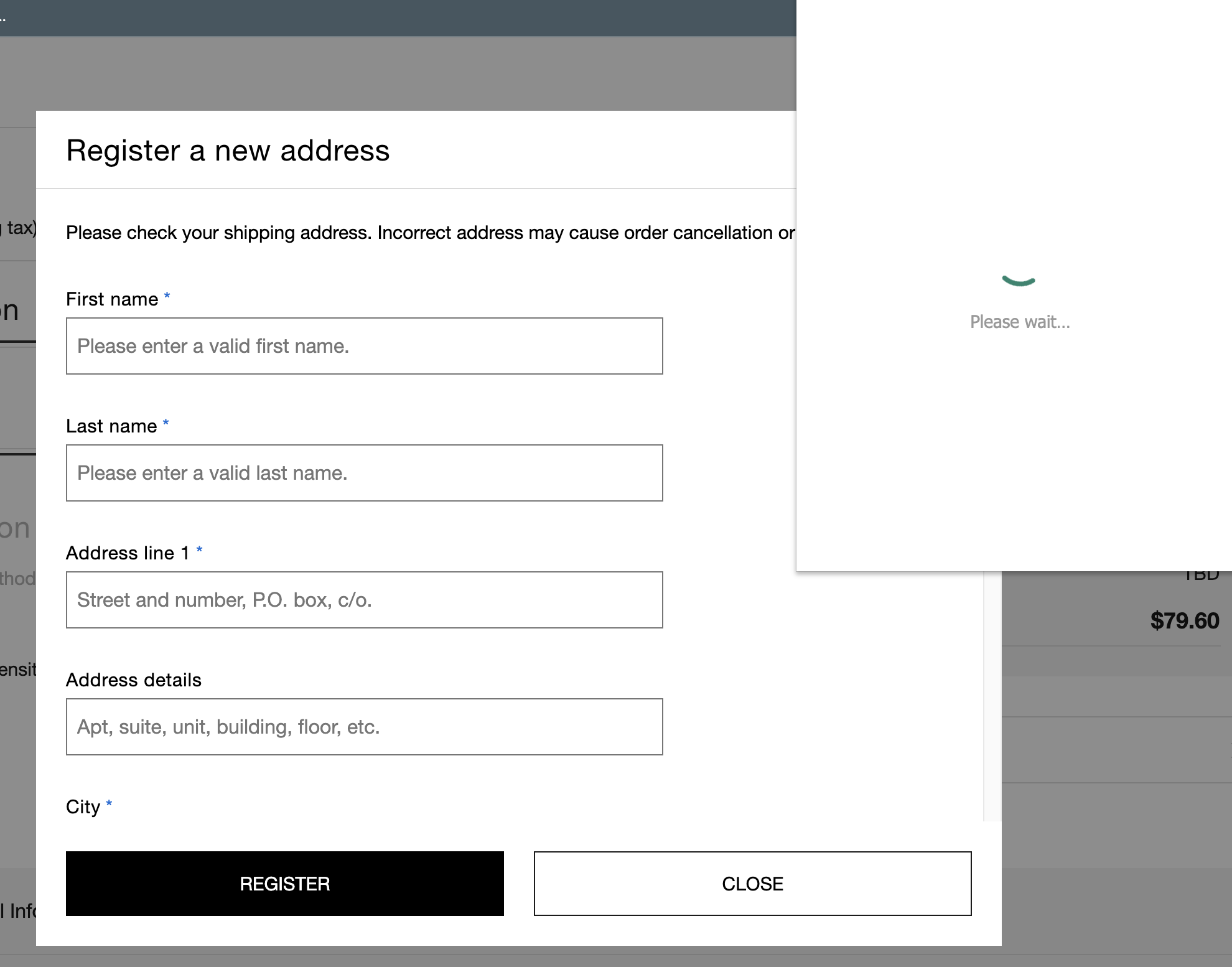
I was also unimpressed with Kaspersky’s website, which offers little product information. Platform compatibility and storage limits are important considerations when shopping for a password manager, and this information was difficult to find.
Kaspersky Form Filling
Overall: (3.0)
As a pure password manager, Kaspersky’s performance is adequate, autofilling and auto-capturing login information just as well as most of the competition.
However, I had issues signing in with multiple Google accounts, as Kaspersky often autofilled information from the wrong account. It also falls behind in autofilling payment information, addresses, and other personal data.
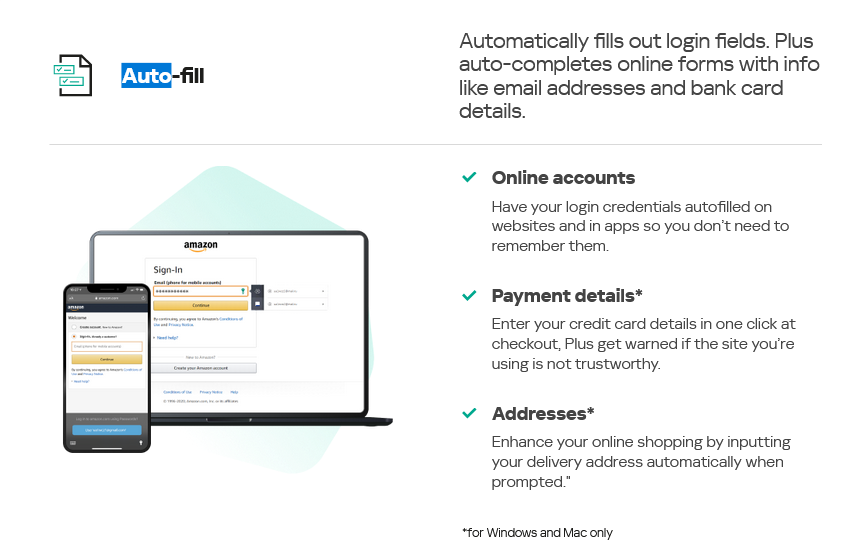
Kaspersky claims to autofill this information and can typically autofill credit card info with little to no error. However, during my testing, I found that it rarely worked with addresses. With each test, Kaspersky would either input nothing or populate information into the wrong field. This is a major shortcoming, especially considering its claims.
Kaspersky Security
Overall: (4.0)
Nothing stands out about Kaspersky’s security features. The highlights include 256-bit AES encryption, no-knowledge architecture, and 2FA — great, but typically the industry standard. Usually, password managers offer features like dark web monitoring, VPNs, and self-destruct mode –– things that Kaspersky does not.
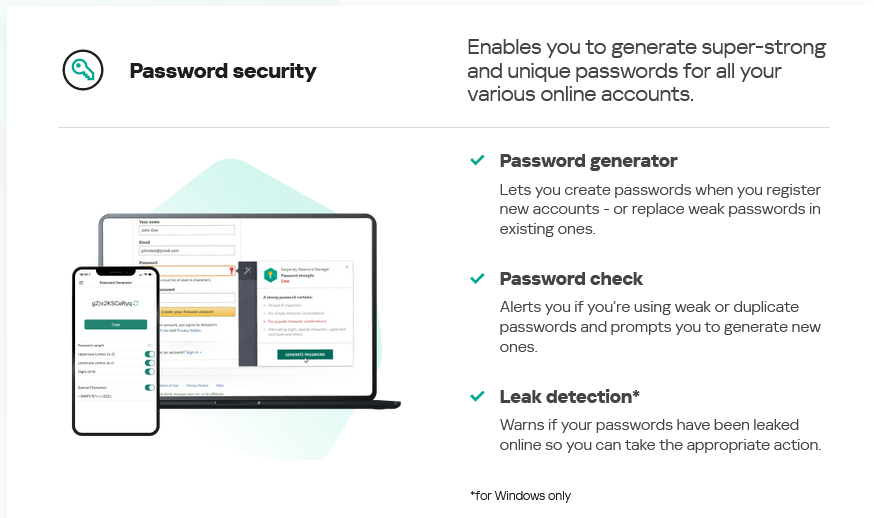
Kaspersky Two-Factor Authentication
Overall: (4.0)
Kaspersky includes 2FA, a feature I believe any worthwhile password manager should offer. Even its free version includes 2FA. By enabling 2FA, you can guarantee only you have access to your passwords.
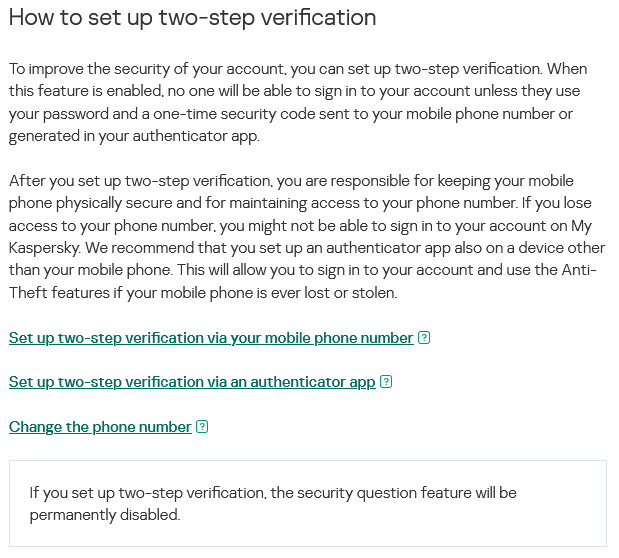
Currently, Kaspersky’s 2FA is limited to phone numbers and authenticator apps. These options are satisfactory, yet far from outstanding. Personally, I prefer it when password managers offer biometric 2FA, the most secure and convenient form.
Recent Improvements to Kaspersky
- Step 1.Dark or light themes available, or one specified in your operating system
- Step 2.Ability to import passwords from Yandex Browser and Microsoft Edge (Chromium)
- Step 3.Browser extensions updated to meet new security standards
- Step 4.Improved password check algorithms
Compare Kaspersky Alternatives
Kaspersky exists in a crowded market of powerful password managers. Competitors, including Dashlane, Keeper, Roboform, LastPass, and NordPass offer unique features at different price points that could make them a better fit.
We looked closely at each password manager, spent time using the services, and researched each for hours. We’ll provide objective information about each company so you can find the best for you.
See how Kaspersky compares to other top-tier password managers the PasswordManager.com team recommends:
| Password manager | Details | Basic plan features |
|---|---|---|
| Kaspersky Overall rating: (3.7) | Starting price: Free Platform compatibility: Android, iOS, Mac, Web (Chrome, Edge, Firefox, Safari), Windows Security: AES 256-bit encryption, 2FA, leak monitoring (Windows only) |
|
| 1Password Overall rating: (4.8) Read our full 1Password review. Consider 1Password if: You’re seeking unlimited password management at a fair price. | Starting price: $2.99 per month Platform compatibility: Android, iOS, Linux, Mac, Web (Brave, Chrome, Edge, Firefox, Safari), Windows Security: AES 256-bit encryption, 2FA |
|
| Dashlane Overall rating: (4.7) Read our full Dashlane review. Consider Dashlane if: You’re only interested in a personal plan. | Starting price: Free Platform compatibility: Android, iOS, Mac, Web (Chrome, Edge, Firefox, Safari), Windows Security: AES 256-bit encryption, 2FA |
|
| Keeper Overall rating: (4.6) Read our full Keeper review. Consider Keeper if: You want to enjoy the feature of secure biometric logins. | Starting price: $3.75 per user Platform compatibility: Windows, MacOS, Linux, Android, iPhone, and iPad. Browser extensions for Safari, Opera, Internet Explorer, Firefox, Edge, Chrome Security: AES 256-bit encryption, PBKDF2 |
|
| Roboform Overall rating: (4.5) Read our full Roboform review. Consider RoboForm If: You want to sync your passwords through multiple platforms and won’t mind its compatibility with fewer platforms than 1Password. | Starting price: $24 per year Platform compatibility: Windows, Mac, iOS, and Android support for their respective major browsers, including Microsoft Edge Security: AES 256-bit encryption, 2FA |
|
| NordPass Overall rating: (4.3) Read our full NordPass review. Consider NordPass if: You don’t want different packages for your family and business. | Starting price: $2.49 per month Platform compatibility: Windows, macOS, Linux, Android, iOS, and popular browsers, such as Google Chrome, Firefox, Edge, Brave, Opera, and Safari Security: XChaCha20 encryption algorithm and a zero-knowledge policy |
|
Frequently Asked Questions About Kaspersky
Can Kaspersky be trusted?
Kaspersky is under much scrutiny due to security concerns. Because it is a Moscow-based company, the U.S. government fears its software can be manipulated to cause harm to U.S. cybersecurity.
Kaspersky refutes such claims, and its products remain available to the general public. But this situation is worth monitoring for those interested in Kaspersky.
What are the cons of Kaspersky?
Kaspersky’s biggest drawback is its lackluster browser extension. In addition to poor autofill performance, the browser extension does not allow you access to your vault.
Is it worth paying for Kaspersky?
Despite its low price, I recommend choosing a free password manager like Bitwarden or spending more on a premium password manager like Dashlane.
What Is Kaspersky the Company?
Kaspersky Lab is a Russian multinational cybersecurity and anti-virus provider founded in 1997 by Eugene and Natalya Kaspersky, and Alexey De-Monderik. Between 2005 and 2010, it underwent international expansion, resulting in an annual revenue of $704 million by 2020. As of 2016, its software boasts roughly 400 million users worldwide.
- 500 Unicorn Pk., First floor, Woburn, Massachusetts 01801
- +1-866-328-5700 (toll-free)
- [email protected]
- Official website
- YouTube
How I Rated Kaspersky
Our rating process involves a thorough and detailed study of the various features stacked against the competition. I looked at the multiple facets and features provided by Kaspersky compared to other significant industry players through direct testing to ensure an accurate rating. I’ve also applied my experience using Kaspersky to provide a user’s perspective.
I signed up for a plan with Kaspersky to test:
- Plan value: Most password managers offer various subscription plans from free to around $20 per month. While free plans may be sufficient for some, those that need more functionality may prefer paid plans.
- Platform compatibility: You likely access your online accounts from multiple devices, including desktops, laptops, tablets, phones, as well as through different web browsers. Your password manager should be compatible with various devices, operating systems and browsers, and sync seamlessly between them all.
- UX: This is how you interface with all the features and functions of your new password manager — if it’s bad, you’ll be less likely to use the service. While this is a highly subjective category and some will disagree, it’s important to provide an overview based on my experience.
- Form filling: A password manager doesn’t have to include form-filling, but it’s somewhat standard and the ease with which it performs that function can be the deciding factor in which password manager you ultimately choose.
- Security: Since a password manager is first and foremost a security tool, it should come with all of the most up-to-date standard security features. This includes the highest level of available encryption (256-bit AES with PBKDF2-HMAC-SHA512); 2FA, such as biometric logins or multi-factor authentication, and a password generator.
- Two-factor authentication (2FA): Used all over the internet to protect your accounts, this is quickly becoming a standard security practice. 2FA is a great way to secure more sensitive accounts to ensure they’re not breached.
Learn more about our review methodology.

About The Password Manager, Gunnar Kallstrom:
Gunnar Kallstrom is a Cyber Team Lead for a DOD contracting company in Huntsville, AL, and has also worked as a CND Cyber Analyst. An author and content creator for a cybersecurity academy, Gunnar spent nearly 15 years in the Army as a musician before entering the cybersecurity field.
He holds a bachelor’s degree in music from Thomas Edison State University and a master’s in organizational development and leadership from the University of the Incarnate Word.
Kallstrom has completed several CompTIA courses, including Secruity+, Network+, A+ Core 1, and A+ Core 2. He earned a CompTIA Security+ Certification. Additionally, he has completed the Cyber Warrior Academy program with more than 800 hours of hands-on, intensive, and lab-driven technical training in cybersecurity methods and procedures.
Passionate about all things cyber, Kallstrom was a speaker on a panel at the 2022 InfoSec World conference, giving a talk entitled “Hacking into a Cyber Career – True Stories.” Kallstrom is also a mentor to entry-level cybersecurity candidates seeking to break into the field. When he’s not working, he still enjoys playing guitar and fishing (not phishing).
Related Posts
Hideez Authentication Service Review 2024: Expert Rated 4.3/5
We put Hideez Authentication Service to the test for plan value, compatibility, features, and security. See why The Password Manager… Read More
NordPass Password Manager Review 2024: Expert Rated 4.3/5
With high-end security features, NordPass is a notable password manager with a solid free plan. Its premium price and limited… Read More
Google Password Manager Review 2024: Expert Rated 3.8/5
Google’s Chrome browser can do much of the work stand-alone password managers can. Still, think twice about how Google handles… Read More
Yandex Password Manager Review 2024: Expert Rated 4.1/5
We put Yandex password manager to the test for plan value, compatibility, features, and security. See why The Password Manager… Read More
Password Safe Password Manager Review 2024: Expert Rated 3.6/5
We put Password Safe password manager to the test for plan value, compatibility, features, and security. See why The Password… Read More
Table of Contents
- Kaspersky: A Quick Overview
- What Are the Pros and Cons of Kaspersky?
- Who Should Choose Kaspersky?
- Kaspersky Plans and Pricing
- Kaspersky Platform Compatibility
- Kaspersky UX
- Kaspersky Form Filling
- Kaspersky Security
- Kaspersky Two-Factor Authentication
- Recent Improvements to Kaspersky
- Compare Kaspersky Alternatives
- Frequently Asked Questions About Kaspersky
- How I Rated Kaspersky
